The ASUS ROG Strix B360-G Gaming Review: A Polarizing $100 Motherboard Design
by Joe Shields on September 25, 2018 8:00 AM EST- Posted in
- Motherboards
- Intel
- Asus
- MicroATX
- CrossFire
- M.2
- Coffee Lake
- i7-8700K
- B360
Visual Inspection
Our first close look at the board shows the MicroATX offering has quite a bit going on visually. All the stenciling spread across the length of the board is pretty hard to miss. We can see two large heatsinks as well as an IO cover which is a bit different from the B360 boards we have reviewed so far - up to this point other boards have eschewed large heatsinks, and focused on cost savings. To ASUS' credit the rear IO plate is also integrated giving the board a premium look on that front.
The PCB is black with all connectors coming in black as well. The primary PCIe slot is fortified to assist with large and heavy graphics cards. The ASUS ROG symbol graces the chipset heatsink. The stenciling using words/phrases doesn't really do much for the look of the board. I cannot say how it will be received by the public, but I know I would have preferred the board without that design for sure.
The ASUS B360-G Gaming also includes LEDs on the bottom part of the board and run along the left side close to the audio separation strip. The LEDs are RED in color and creates a nice theme matching glow from the bottom of the board. The colors are not able to be changed by the Aura software. That said, the board does include an RGB strip header which makes adding your own strip easy.
On the cooling side of things, the mATX board gives users a total of four 4-pin fan connectors located around the board. The CPU fan header is located above and to the right of the CPU socket next to the first DRAM slot. A chassis fan header, as well as an AIO_Pump connector, are located mid-board behind the audio stack on the left side of the board and above the primary PCIe slot. The last chassis fan header is located on the bottom of the board below the chipset. ASUS does not mention the output capabilities of these headers. The fans are able to be controlled through the BIOS and the AI Suite software with the ports support both PWM and DC control.
The power delivery section on the B360-G Gaming uses ASUS' Digi+ VRM which is likely based off of an International Rectifier part and controls the six phases we are able to see. The low and high side MOSFETs are On Semiconductor 4C06B and 4C10B ICs. This setup was plenty to keep a stock i7-8700K in check.
Swing around to the right side of the board, we can see the four single-sided locking DRAM slots and a full set of six SATA ports are all visible. Two of the SATA ports are mounted horizontally while the four others are oriented vertically. We are also able to see a USB 3.0 header, as well as the 24-pin ATX power lead for the board.
On the bottom half of the board, starting on the left side, we are able to see the Supreme FX audio chip which ASUS says has a better SNR than the Realtek ALC1220 codecs, is shielded and uses Nichicon audio caps. It also includes two onboard op amps for the front panel with a 32-600 Ohm range for headphones. It is nice to see premium audio used on a chipset designed to be more cost-effective than including higher-end features.
The middle is where we see the two M.2 slots (just above each full-length PCIe slot) as well as four PCIe slots. The first/top PCIe slot is fortified with ASUS' Safeslot to prevent shearing from heavy video cards and is the primary slot for the GPU. We can also see two x1 slots and the second full-length PCIe slot (runs at x4). The top slot is fed from the CPU while the x1 slots and bottom slot are fed from the chipset. This configuration allows for the board to support Crossfire setups, but not NVIDIA SLI.
| ASUS ROG Strix B360-G Gaming CPU PCIe Layout | ||
| 16-Lane Single |
16-Lane Dual |
|
| PCIe 1 | @x16 | @x16 |
| PCIe 4 (Chipset) |
- | @x4 |
| SLI | - | No |
| Crossfire | - | Yes |
Outside of that, we can see miscellaneous headers across the bottom. These range from front panel audio, USB 2.0 headers, as well as a chassis fan, and finally, the front panel header on the bottom right-hand corner.
The rear IO panel is pretty full featured for a B360 motherboard including USB 2.0, 3.0, and 3.1 (10 Gbps) ports on the back along with a full audio stack including an optical jack. Video output is handled by an HDMI port and DVI-D port. The board also includes a PS/2 port for legacy keyboard/mice as well as a single LAN port which includes ASUS' anti-surge guard to protect from ESD. The only core thing missing from the rear from a pricier system is a Type-C port.
- 1x PS/2 keyboard/mouse combo port
- 1 x DVI-D
- 1 x HDMI
- 2 x USB 3.1 (10 Gbps) Type-A ports
- 1 x Optical S/PDIF out
- 5 x Gold-plated audio jacks
- 2 x USB 3.0 ports (blue)
- 2 x USB 2.0 ports (black)
In the Box
ASUS includes the following:
The package includes everything a user needs to set the board up and running.
- User Manual
- Support DVD
- 2 x SATA cables
- 1 x M.2 screw
- 1 x Door hanger
- 1 x cable tie package
- 1 x ROG stickers



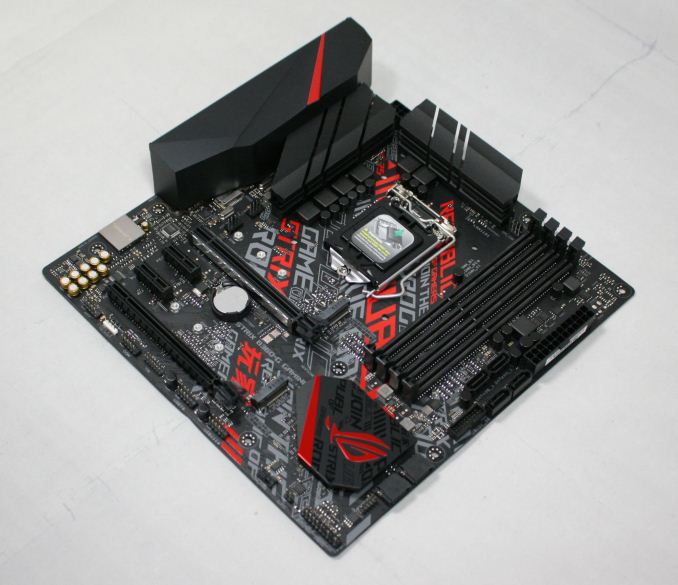
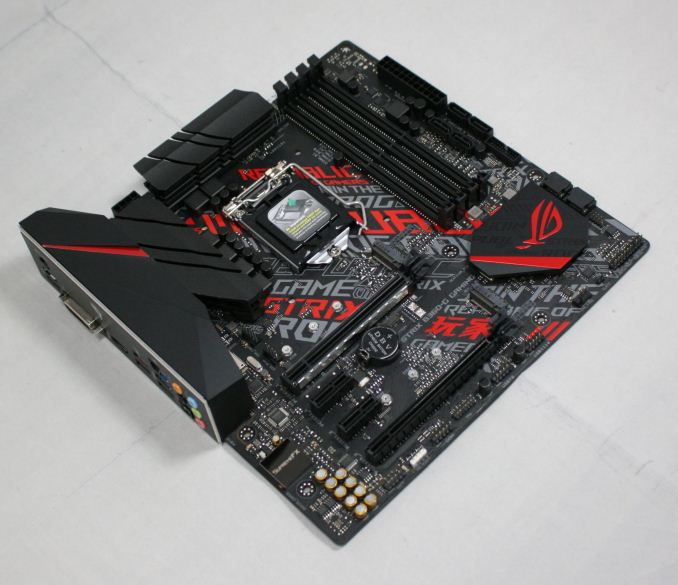
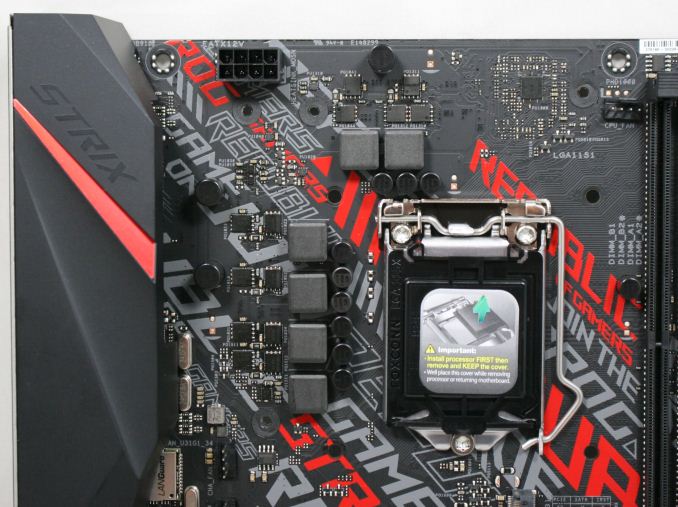
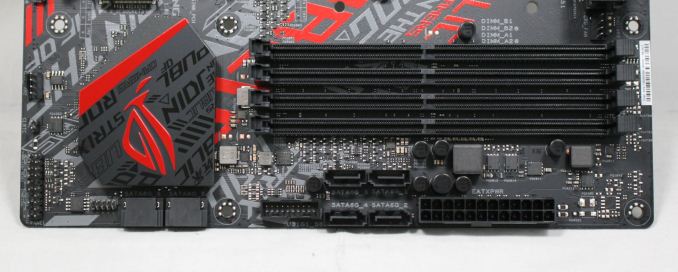
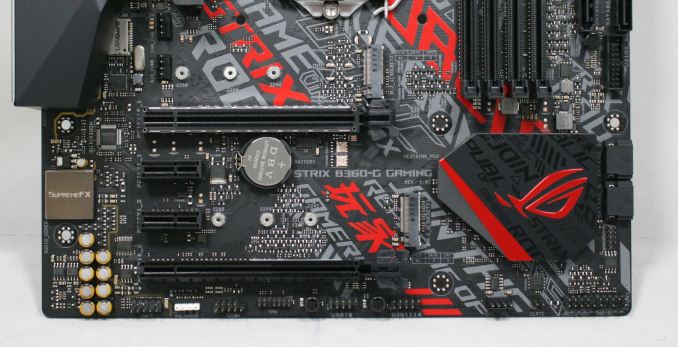
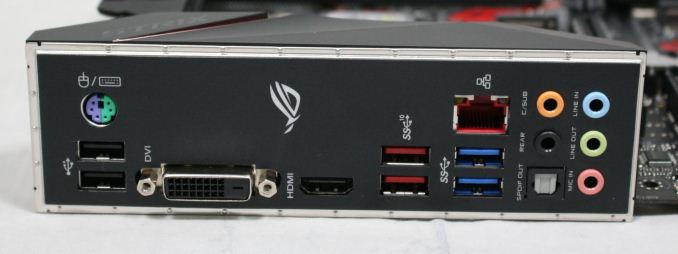















26 Comments
View All Comments
V900 - Thursday, September 27, 2018 - link
That poor, defenceless board!It looks like it was assaulted by some hoodlums with spraycans... Like a subwaycar the morning after the guard in the train yard called in sick.
I guess I shouldn't care though, since Id just keep it locked up in a glassless cabinet anyways.
V900 - Thursday, September 27, 2018 - link
I can sorta understand being proud about being a gamer.(Ok, not really. But its certainly nothing to be ashamed about.)
What I DONT understand, and what kinda irks me, is being obnoxious and loud about being a gamer.
And thats unfortunately a great way to sum up the design-language of 90% of all these LED flashing, "Gamer" styled system components and PC accessories.
"Obnoxious and loud about being a gamer."
araczynski - Friday, September 28, 2018 - link
Duuuude, EVERYone knows you can't be a 'leet fortnite/esports contender if your gaming rig doesn't look like it was bukkaked by a gay unicorn.mip1983 - Tuesday, October 2, 2018 - link
Why do modern motherboards still have PS2 and DVI ports? Remove for more USB's plz (only 3+ or c).dromoxen - Thursday, October 4, 2018 - link
It is missing built in wifi tho the improved audio might be noticeable. And is the red really as bright, or has someone done something wiith the hue slider . Can never have enough usb ports , even maybe usb2 if someone wants to install win7 or SolarisRootyTooty - Friday, January 18, 2019 - link
The specs listed here for the M.2 sockets do not match the ASUS website. Here are the official specs:1 x M.2 Socket 3, with M key, type 2242/2260/2280 storage devices support (PCIE 3.0 x 4 mode)*
1 x M.2 Socket 3, with M Key, type 2242/2260/2280 storage devices support (SATA & PCIE 3.0 x 2 mode)
How much difference does it make in real-world usage that the second M.2 slot is only x2 instead of x4?